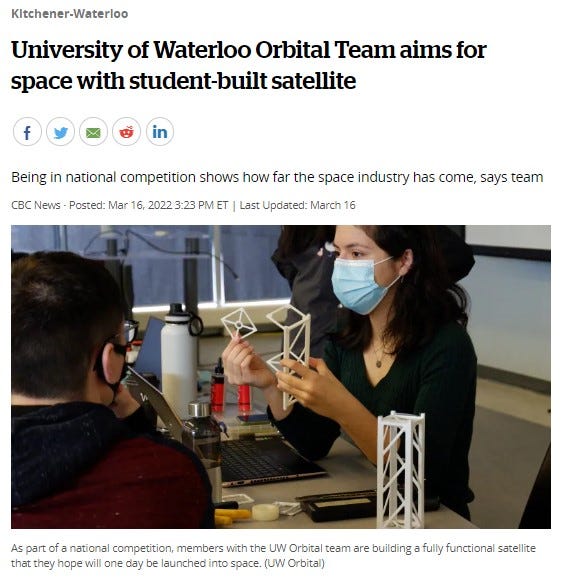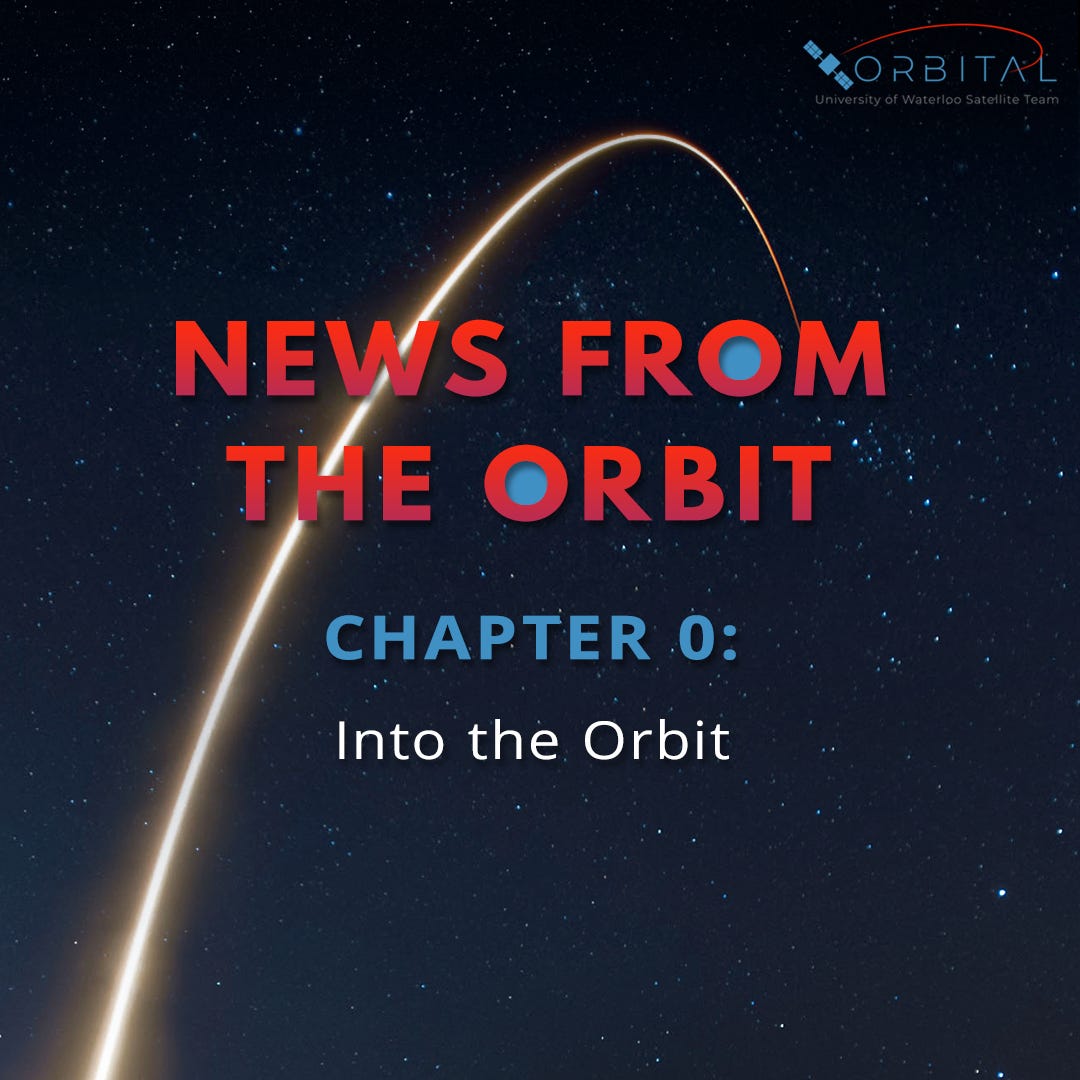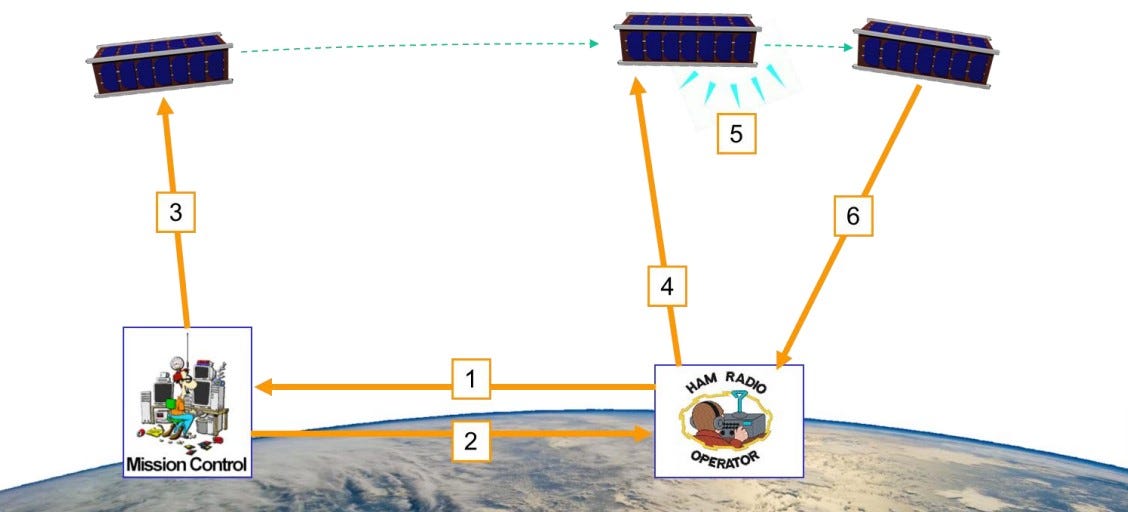Chapter Zero: Into the Orbit
6.2 min read
A group of 90 ambitious students and one mission – UW Orbital plans to produce the first CubeSat, Eternium-III, developed out of the University of Waterloo. In order to establish a space program at the university, we hope to be able to launch it into space within the next decade through the Canadian Satellite Design Challenge (CSDC) by furthering student involvement in the space industry.
The Canadian Satellite Design Challenge is a two-year long competition that involves nearly a dozen universities across Canada, with the aim of building a functional CubeSat. The CSDC helps fund the winning team's launch and ground station equipment costs.
As part of the competition, the satellite must go through a Preliminary Design Review (PDR) and a Critical Design Review (CDR), meant to mimic an industry standard development cycle. In May of 2023, the satellite will also perform a vibration test, where the CubeSat will be placed on a shaker bed and subjected to random vibrations to ensure that it can endure the forces of a rocket launch.
UW Orbital was established in May 2021, and since then the team has been working hard to build Eternium-III. To also celebrate our one year anniversary, we have gathered all the amazing milestones that we have crossed so far.
CubeSat? What’s that?
CubeSats are low-cost alternatives to the typical multi-million-dollar satellite projects you may be familiar with. These small-footprint satellites open the door for student teams to be able to get involved in the space industry early in their career. CubeSats come in several different sizes, the smallest being 1U (10 cm x 10 cm x 10 cm), and the largest being 24U (20 cm x 30 cm x 40 cm). For the CSDC, UW Orbital is required to build a 3U (10 cm x 10 cm x 30 cm) CubeSat - that's just about the size of three Rubik's cubes stacked on top of one another!

On launch day, CubeSats are attached to larger satellites on rideshare missions. As a result, the total cost to launch is reduced to as low as $200K instead of millions of dollars. Once the main satellite has been launched, CubeSats are pushed out into space via a spring in the dispenser.
Eternium-III's Mission
UW Orbital is currently developing two main payloads for the Eternium-III mission.
For the CSDC, the team is building a Selfie-Sat camera - an imager designed to take orbital photos for Amateur Radio Operators (AROs), also known as hams, all with the goal of furthering amateur radio education and enabling young children to get involved in STEM and the space industry.
Additionally, UW Orbital is working with a company named QEYnet for a secondary mission that will also launch on board Eternium-III. The company is run by industry experts such as Cordell Grant, COO of Sinclair Interplanetary by RocketLab, and is advised by Professor Jennewein of the Physics Department at the University of Waterloo. QEYnet is building a new key distribution method to counter the threats posed by advancements in quantum computing in order to keep internet communications secure.
To do so, the company plans to build a swarm of nanosatellites to implement a quantum-secure algorithm known as Quantum Key Distribution (QKD) - a method that uses properties of photons such as entanglement to easily detect third party attacks. Each satellite would be able to beam down randomly generated keys to ground stations at point A and point B, which can then use that key to communicate securely over the internet instead of participating in any insecure exchanges. QEYnet’s nanosatellites will include two components: a visible-wavelength laser beam that sends down the keys and an infrared-wavelength laser beacon, which is used to assist in tracking the location of the satellite as it travels over the ground station.
UW Orbital intends to fly a prototype of this laser beacon, which QEYnet will develop, on its first flight. This, however, poses a unique challenge that the Orbital team has been working to solve.
The beacon requires a relatively strict pointing accuracy of about 0.2 degrees. Developing an Attitude Determination and Control System (ADCS) with such strict requirements is quite expensive, particularly for a new team. The payload team is therefore working on a novel solution for low-cost, accurate pointing that involves using the onboard camera to detect a laser beamed up from the ground station to the satellite.
Meet the Team
The UW Orbital team was formed to change our vision into action and this was possible through the tremendous efforts of the members themselves and through the close guidance of Dr. George Shaker from the ECE and MME Departments.
The team is made up of 7 subteams who overlook certain subsystems or operations. Electrical Power Systems (EPS) is responsible for power production, distribution, and management; Command & Data Handling (CDH) manages the development of the onboard computer (OBC) and its operating system as well as the integration of all other applications; Communications handles the interface between the ground station and CubeSat; Attitude Determination and Control System (ADCS) is responsible for assisting with orientation control of the satellite within space through tools such as magnetorquers, reaction wheels, and sensors; Mechanical is responsible for the overall satellite frame structure, any required internal architecture, and performing the Finite Element Structural and Thermal Analysis for CubeSat frame designs in addition to proposed electrical layouts; Payload is in charge of the Selfie-Sat camera, and the secondary payload, QEYnet’s infrared laser beacon; and Business is responsible for coordinating the team’s social media accounts, developing marketing materials, running outreach events, holding recruiting events, handling finance/budgeting, and reaching out to sponsors and mentors.
As our team continues to grow, the members also learn a lot from one another by sharing the knowledge and experiences they have gained through their programs. Out of the 90 students, over 83% of the team is from the Faculties of Engineering, Math, and Science. Specifically, 68% of engineering students make up our team of which 63% are MME students, 14% are ECE students, and 8% are SYDE students. As for the rest of the team, 16% of the members are from the Faculties of Math and Science and the remaining 16% are from the Faculty of Arts.
Key Milestones
Within the past year, the team has achieved several important milestones for this project. Some of our biggest accomplishments are:
Growing the team to over 90 active members from faculties across UW, including programs such as Accounting & Financial Management, Physics, Math, Computer Science, and all engineering programs, from MME to ECE and SYDE
Supporting the UW student body with events such as resume critiques & fireside chats with industry leaders like Martha Lenio and Sohrab Haghighat
Hosting educational outreach events at various schools and UW campus events to educate students about space, CubeSats, and the work at UW Orbital
Being featured in news articles written by the CBC, Waterloo Region Record, and University of Waterloo

Partnering with QEYnet to launch an infrared laser beacon to demonstrate the readiness of Quantum Key Distribution (QKD) technology
Collaborating with 20 sponsors to support the development of the team's first CubeSat
Working with various organizations such as Royal Astronomical Society of Canada and the Mississauga Amateur Radio Club to support outreach initiatives at their meetings and to introduce UW Orbital and our vision as a student design team
Raising crucial funding for satellite development through the support of UW funds like WEEF, EngSoc, and MEF, as well as external sources such as Kickstarter campaigns and grants from IEEE Canadian Foundation and Rising Youth
Completing the design of a novel pointing mechanism to support the laser beacon, involving tracking of a ground station laser to achieve 0.1-0.2 degrees of accuracy
Developing several in-house electrical systems, such as a UHF transceiver, onboard computer, and an MPPT-driven power system
Devising an in-house CubeSat chassis, including proper thermal and FEA modeling
Building an in-house attitude determination and control system, including magnetorquers created with a custom winding mechanism

Appreciations
Most importantly, none of the above achievements would have been possible without the immense support from countless people, and so the UW Orbital team is tremendously thankful to all our sponsors, including: Siemens, AGI, Demtool Inc., RLX Solutions Inc., University of Waterloo Faculty of Engineering, Waterloo Engineering Endowment Foundation (WEEF), Math Endowment Fund (MEF), University of Waterloo Engineering Society (EngSoc), Altium, Hakko, Notion, VectorNav, IEEE Canadian Foundation, Pelican, Rising Youth, Canada Service Corps, Government of Canada, TakingIT Global, Great Scotts Gadgets, RTL-SDR, Waterloo Electroplating & Metal Finishing, SpeedPro, Stratodynamics Aviation Inc., and Wix. All their contributions have made it possible for us to continue working to bring the space industry closer to Waterloo students.
We would also like to show our gratitude to our supporters: the Sedra Student Design Centre (SSDC), QEYnet, WatSat, Waterloo Rocketry, Space Concordia, AlbertaSat, Waterloop, UManitobaSat, Waterloo Aerial Robotics Group (WARG), CalgaryToSpace Team, University of Toronto Aerospace Team (UTAT), Mississauga Amateur Radio Club (MARC), Royal Astronomical Society of Canada (RASC), UW Baja SAE, and several University of Waterloo faculty and students, including Dr. Kamyar Ghavam, Dr. Charles Kwan, and PhD student Gurpreet Singh for backing our vision and following us through this challenge. We want to give special thanks to our team advisor, Dr. George Shaker and Dr. Peter Teertstra for guiding us along every step.
On behalf of all UW Orbital members, I, Ariba Khayyam, want to thank you all again for your support on this project and hope that you continue to follow our journey till its completion through our progress updates here. I would also like to thank all the members for putting so much of their time and efforts into this project. We hope to make everyone’s contributions worthwhile, and perhaps one day, we’ll reach space.
This was News from the Orbit – now signing off!
Connect with us on LinkedIn and Instagram and check out our UW Orbital site.
Interested in keeping up with UW Orbital? Subscribe below if you haven’t already!






